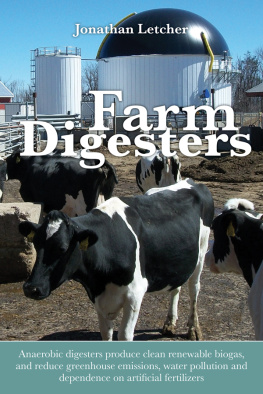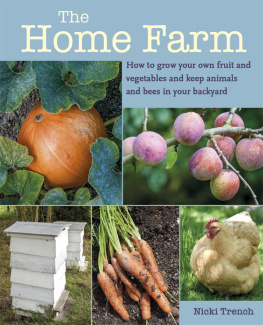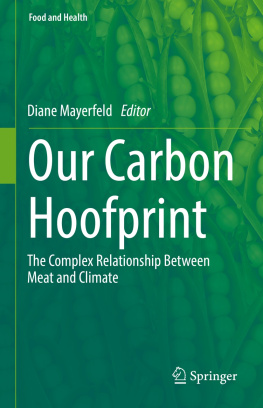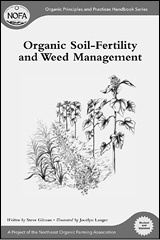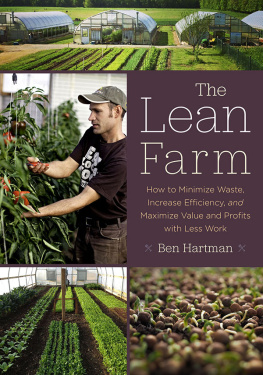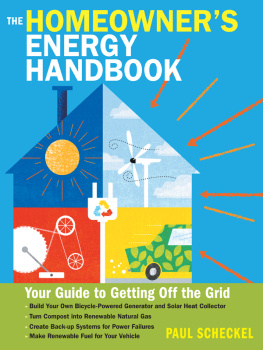Farm
Digesters
Farm
Digesters
Anaerobic digesters produce clean renewable biogas, and reduce greenhouse emissions, water pollution and dependence on artificial fertilizers
Jonathan Letcher
Contents
For Arnold Black C.E. Inst. Chem. E.M.
Inst. K.T. 1953-2012
Foreword
The Royal Agricultural Society of England (RASE) supports on-farm anaerobic digestion for the treatment of farm and food waste.
Anaerobic digestion (AD) is much more than a renewable energy technology. It provides wider benefits for waste and nutrient management, whilst reducing farm-scale greenhouse gas (GHG) emissions. It also provides an alternative and stable income stream for producers.
However, this is something which is often unrealised by wider audiences, and is what Jonathan addresses in this book through highlighting the importance of digesters, what benefits they provide and future opportunities for sustainable production.
Unfortunately, to date, development in on-farm AD has been limited in the UK. Reasons for this vary, however one of the biggest barriers to adoption has been uncertainty over future government policy.
This has subsequently stifled investment in the technology right from development through to production. Furthermore legislation surrounding waste products has caused confusion and prohibited projects going ahead.
These issues can only be addressed by a wider understanding of the role that digesters can play in sustainable farming systems and the supply of green energy to rural communities.
The Royal Agricultural Society of England (RASE) has been involved in promoting on farm renewable energy for a number of years, and in particular anaerobic digestion. Most recently it has looked in detail at the role for the farm of the future and its potential to become an important source of renewable fuel and energy, as well as food production.
Farms are best placed to play a key role in a sustainable energy system. However there must be a greater understanding of the barriers to sustainable farm-based energy, strong financial and performance data available and incentives that make it attractive and profitable for farmers.
It is time the wider society understands fully the multiple benefits of on-farm digesters and gives them the support required to ensure a sustainable future for food and energy production.
David Gardner, CEO, Royal Agricultural Society of England, 2015
Preface
Much of this book is based on my own personal experience of the digester industry, and on that of former colleagues. But some parts have inevitably been drawn largely from research. Wherever possible I have used official government statistics or publications, but in one or two cases I have had to resort to less reliable sources, such as Wikipedia, which may not have been as rigorously researched or kept as up-to-date as the information in official publications. Most of the sources are given in the appendix, as are any calculations I may have made, based on those sources, to supply any specific figures I needed which I could not find elsewhere. The chapter about digesters around the world has been based on so many different publications that in this particular case I felt it best to simply list them all in the appendix, rather than note the sources of specific key details, as I have elsewhere.
There can sometimes be variations between two different, and equally reputable, research papers on the same subject. For example, estimates of the number of biogas plants operating in China varied considerably, perhaps because their number has been increasing very rapidly even over the last few years. When compelled to make a choice, I used the sources which came to me through people who seemed most experienced in that field. During the two years since I first began my research, some of the official and other websites I consulted have changed their content or their routes to information. Although most of the information should still be available elsewhere, some details I have quoted may now be harder to locate.
I have done my best to ensure that all the information in this book is as accurate as possible, and several specialists and former colleagues have kindly given up their time to help me check my facts and figures. But digesters cover many different fields, and some inaccuracies or disputable interpretations may have slipped through the net. If this has happened, any corrections or suggestions that anyone is kind enough to send me will be welcomed, to improve the accuracy of any possible future editions of this book.
This book is intended to give an overall picture of farm digesters, their benefits, and the issues affecting their future. It should not be used to calculate the possible viability of a specific project. Anyone considering installing a digester must first seek advice from a suitably qualified specialist; the author and publisher can accept no responsibility for any loss arising from any information or opinions given in this book.
Acknowledgements
Without the help of a great many people this book could not have been written. It would be impossible to thank everyone who has helped me in one way or another, but I am particularly grateful to those people who have taken the trouble to send me or point me towards important sources of information which I might otherwise have struggled to find, especially Alison Wray, Martin Allan, Lindsey Clothier and David Fernall of DEFRA, Dr. David Styles of Bangor University, Patrick Serfass, the Executive Director of the American Biogas Council, the staff of AGSTAR (particularly Allison Costa), the US Governments farm digester organization, and above all Wim van Nes of the SNV (the Netherlands Development Organisation), who has not only found time in his very busy schedule to send me some fascinating information on his organizations digester programmes in Asia, Africa and South America, but has very kindly allowed me to include photographs from the SNV website.
I would like to thank Mr. Minton of Malaby Biogas and all the farmers, such as the Parish family and Robert Vooght of Devon, and Trevor Lea of Clwyd, who have, over the years, given up their time to talk to me about their experience of the digester process, shown me their installations and given me invaluable help in many other ways. I am grateful also to Simon Shuker, formerly of Farm Gas and WRI Ltd, for providing and allowing me to use his picture of a Farm Gas sewage sludge digester, to AGSTAR for allowing me to include a quote from their very illuminating greenhouse gas emission comparisons and allowing me to use some of their photographs of digesters in the USA, to the Financial Times for their permission to include the photograph of the RSA Better Environment Awards ceremony in 1990, and to the RSA itself for permission to use pictures of the Pollution Abatement Technology Award ceremony in 1986. I am also grateful to Dr Claire Lukehurst and Angela Bywater for allowing me to use information from their report on the economics of small farm digesters. I would particularly like to thank Angela Bywater, the author of the excellent RASE report on farm digesters, for helping me in so many other ways, despite being extremely busy with many important projects of her own, by sending me a wealth of information and helping me to check over my figures and calculations, for scanning many of my photographs, and especially for her encouragement and moral support, from first to last.
Above all I must thank my former colleague James Murcott for his constant help and advice, based on his unique experience in this field, for encouraging me to begin and to continue with this book at a time when few people had any interest in the subject, and especially for never wavering in his efforts, in spite of constant discouragements during his forty-year career as Britains leading farm digester engineer, to make the treatment of livestock and other wastes in farm digesters a practical reality.
Next page
